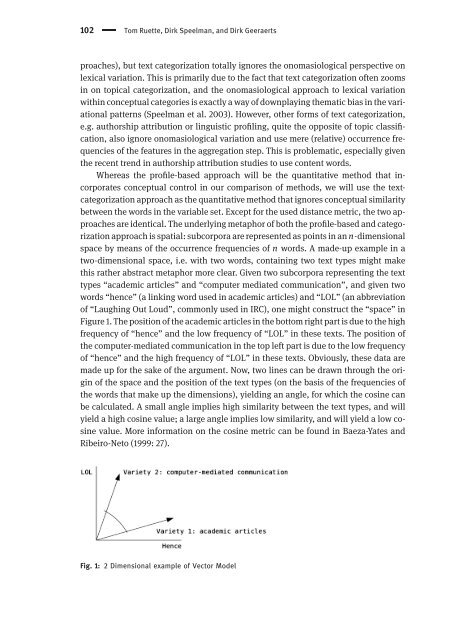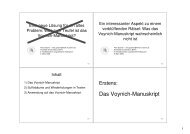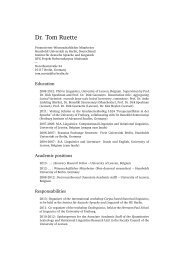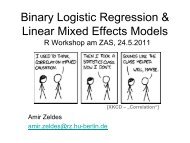Lexical variation in aggregate perspective
Lexical variation in aggregate perspective
Lexical variation in aggregate perspective
Create successful ePaper yourself
Turn your PDF publications into a flip-book with our unique Google optimized e-Paper software.
102 Tom Ruette, Dirk Speelman, and Dirk Geeraerts<br />
proaches), but text categorization totally ignores the onomasiological <strong>perspective</strong> on<br />
lexical <strong>variation</strong>. This is primarily due to the fact that text categorization often zooms<br />
<strong>in</strong> on topical categorization, and the onomasiological approach to lexical <strong>variation</strong><br />
with<strong>in</strong> conceptual categories is exactly a way of downplay<strong>in</strong>g thematic bias <strong>in</strong> the <strong>variation</strong>al<br />
patterns (Speelman et al. 2003). However, other forms of text categorization,<br />
e.g. authorship attribution or l<strong>in</strong>guistic profil<strong>in</strong>g, quite the opposite of topic classification,<br />
also ignore onomasiological <strong>variation</strong> and use mere (relative) occurrence frequencies<br />
of the features <strong>in</strong> the aggregation step. This is problematic, especially given<br />
the recent trend <strong>in</strong> authorship attribution studies to use content words.<br />
Whereas the profile-based approach will be the quantitative method that <strong>in</strong>corporates<br />
conceptual control <strong>in</strong> our comparison of methods, we will use the textcategorization<br />
approach as the quantitative method that ignores conceptual similarity<br />
between the words <strong>in</strong> the variable set. Except for the used distance metric, the two approaches<br />
are identical. The underly<strong>in</strong>g metaphor of both the profile-based and categorization<br />
approach is spatial: subcorpora are represented as po<strong>in</strong>ts <strong>in</strong> an n-dimensional<br />
spacebymeansoftheoccurrencefrequenciesofn words. A made-up example <strong>in</strong> a<br />
two-dimensional space, i.e. with two words, conta<strong>in</strong><strong>in</strong>g two text types might make<br />
this rather abstract metaphor more clear. Given two subcorpora represent<strong>in</strong>g the text<br />
types “academic articles” and “computer mediated communication”, and given two<br />
words “hence” (a l<strong>in</strong>k<strong>in</strong>g word used <strong>in</strong> academic articles) and “LOL” (an abbreviation<br />
of “Laugh<strong>in</strong>g Out Loud”, commonly used <strong>in</strong> IRC), one might construct the “space” <strong>in</strong><br />
Figure 1. The position of the academic articles <strong>in</strong> the bottom right part is due to the high<br />
frequency of “hence” and the low frequency of “LOL” <strong>in</strong> these texts. The position of<br />
the computer-mediated communication <strong>in</strong> the top left part is due to the low frequency<br />
of “hence” and the high frequency of “LOL” <strong>in</strong> these texts. Obviously, these data are<br />
made up for the sake of the argument. Now, two l<strong>in</strong>es can be drawn through the orig<strong>in</strong>ofthespaceandthepositionofthetexttypes(onthebasisofthefrequenciesof<br />
the words that make up the dimensions), yield<strong>in</strong>g an angle, for which the cos<strong>in</strong>e can<br />
be calculated. A small angle implies high similarity between the text types, and will<br />
yield a high cos<strong>in</strong>e value; a large angle implies low similarity, and will yield a low cos<strong>in</strong>e<br />
value. More <strong>in</strong>formation on the cos<strong>in</strong>e metric can be found <strong>in</strong> Baeza-Yates and<br />
Ribeiro-Neto (1999: 27).<br />
Fig. 1: 2 Dimensional example of Vector Model






